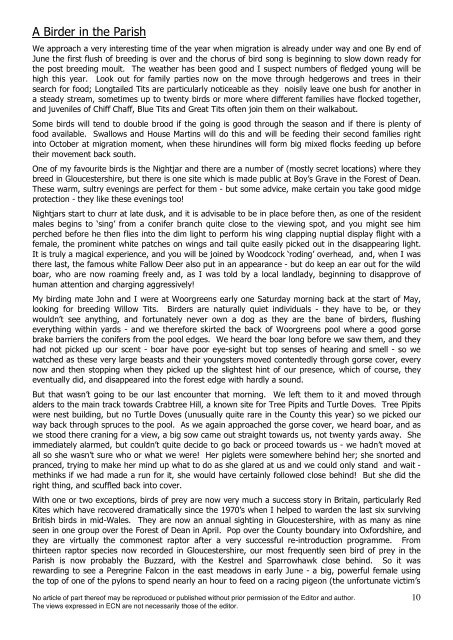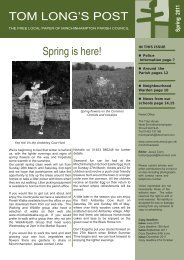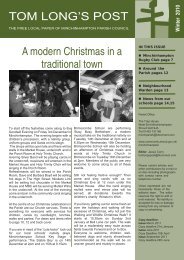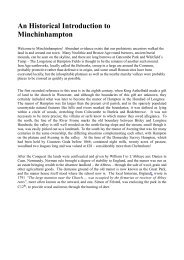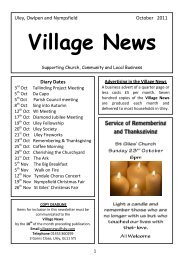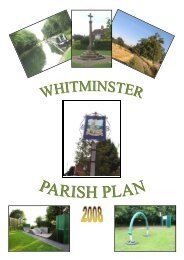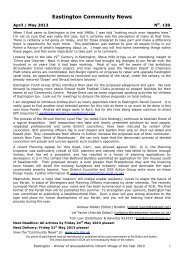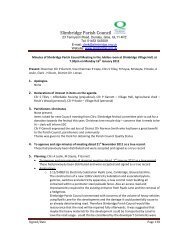Eastington Community News - Stroud District Community Websites
Eastington Community News - Stroud District Community Websites
Eastington Community News - Stroud District Community Websites
Create successful ePaper yourself
Turn your PDF publications into a flip-book with our unique Google optimized e-Paper software.
A Birder in the Parish<br />
We approach a very interesting time of the year when migration is already under way and one By end of<br />
June the first flush of breeding is over and the chorus of bird song is beginning to slow down ready for<br />
the post breeding moult. The weather has been good and I suspect numbers of fledged young will be<br />
high this year. Look out for family parties now on the move through hedgerows and trees in their<br />
search for food; Longtailed Tits are particularly noticeable as they noisily leave one bush for another in<br />
a steady stream, sometimes up to twenty birds or more where different families have flocked together,<br />
and juveniles of Chiff Chaff, Blue Tits and Great Tits often join them on their walkabout.<br />
Some birds will tend to double brood if the going is good through the season and if there is plenty of<br />
food available. Swallows and House Martins will do this and will be feeding their second families right<br />
into October at migration moment, when these hirundines will form big mixed flocks feeding up before<br />
their movement back south.<br />
One of my favourite birds is the Nightjar and there are a number of (mostly secret locations) where they<br />
breed in Gloucestershire, but there is one site which is made public at Boy’s Grave in the Forest of Dean.<br />
These warm, sultry evenings are perfect for them - but some advice, make certain you take good midge<br />
protection - they like these evenings too!<br />
Nightjars start to churr at late dusk, and it is advisable to be in place before then, as one of the resident<br />
males begins to ‘sing’ from a conifer branch quite close to the viewing spot, and you might see him<br />
perched before he then flies into the dim light to perform his wing clapping nuptial display flight with a<br />
female, the prominent white patches on wings and tail quite easily picked out in the disappearing light.<br />
It is truly a magical experience, and you will be joined by Woodcock ‘roding’ overhead, and, when I was<br />
there last, the famous white Fallow Deer also put in an appearance - but do keep an ear out for the wild<br />
boar, who are now roaming freely and, as I was told by a local landlady, beginning to disapprove of<br />
human attention and charging aggressively!<br />
My birding mate John and I were at Woorgreens early one Saturday morning back at the start of May,<br />
looking for breeding Willow Tits. Birders are naturally quiet individuals - they have to be, or they<br />
wouldn’t see anything, and fortunately never own a dog as they are the bane of birders, flushing<br />
everything within yards - and we therefore skirted the back of Woorgreens pool where a good gorse<br />
brake barriers the conifers from the pool edges. We heard the boar long before we saw them, and they<br />
had not picked up our scent - boar have poor eye-sight but top senses of hearing and smell - so we<br />
watched as these very large beasts and their youngsters moved contentedly through gorse cover, every<br />
now and then stopping when they picked up the slightest hint of our presence, which of course, they<br />
eventually did, and disappeared into the forest edge with hardly a sound.<br />
But that wasn’t going to be our last encounter that morning. We left them to it and moved through<br />
alders to the main track towards Crabtree Hill, a known site for Tree Pipits and Turtle Doves. Tree Pipits<br />
were nest building, but no Turtle Doves (unusually quite rare in the County this year) so we picked our<br />
way back through spruces to the pool. As we again approached the gorse cover, we heard boar, and as<br />
we stood there craning for a view, a big sow came out straight towards us, not twenty yards away. She<br />
immediately alarmed, but couldn’t quite decide to go back or proceed towards us - we hadn’t moved at<br />
all so she wasn’t sure who or what we were! Her piglets were somewhere behind her; she snorted and<br />
pranced, trying to make her mind up what to do as she glared at us and we could only stand and wait -<br />
methinks if we had made a run for it, she would have certainly followed close behind! But she did the<br />
right thing, and scuffled back into cover.<br />
With one or two exceptions, birds of prey are now very much a success story in Britain, particularly Red<br />
Kites which have recovered dramatically since the 1970’s when I helped to warden the last six surviving<br />
British birds in mid-Wales. They are now an annual sighting in Gloucestershire, with as many as nine<br />
seen in one group over the Forest of Dean in April. Pop over the County boundary into Oxfordshire, and<br />
they are virtually the commonest raptor after a very successful re-introduction programme. From<br />
thirteen raptor species now recorded in Gloucestershire, our most frequently seen bird of prey in the<br />
Parish is now probably the Buzzard, with the Kestrel and Sparrowhawk close behind. So it was<br />
rewarding to see a Peregrine Falcon in the east meadows in early June - a big, powerful female using<br />
the top of one of the pylons to spend nearly an hour to feed on a racing pigeon (the unfortunate victim’s<br />
No article of part thereof may be reproduced or published without prior permission of the Editor and author.<br />
The views expressed in ECN are not necessarily those of the editor.<br />
10


